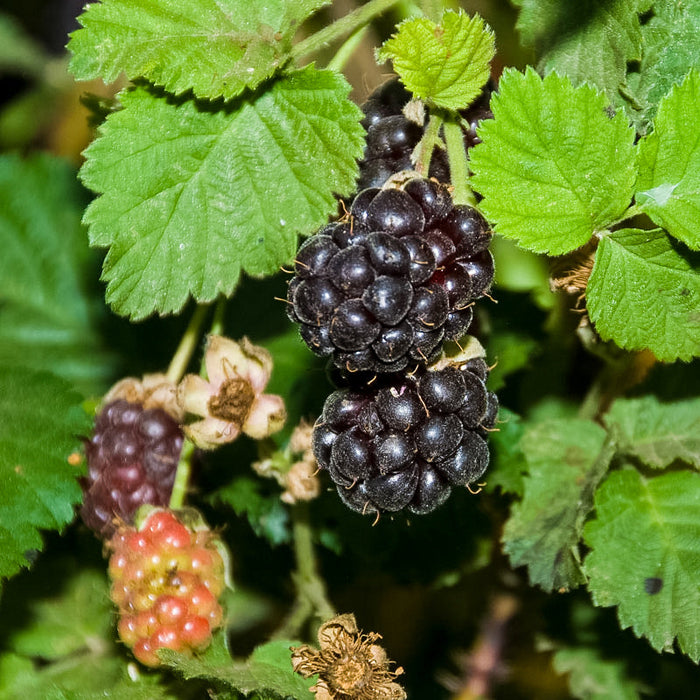
Boysenberry (Potted)
Ship Date
Available to Ship in: January 2026. Order today to reserve yours!
Mix-and-match 4 or more potted berry plants for free shipping!
Boysenberries are a classic variety known for their large, dark purple fruit with a sweet-tart flavor. These versatile berries are perfect for fresh eating, adding to pies, or making preserves. Thriving in full sun and well-draining soil, Boysenberry plants are vigorous and produce heavy harvests in mid-summer. With their bold flavor and high productivity, Boysenberries are a favorite for home gardeners and berry enthusiasts seeking delicious, versatile fruit.
Potted Boysenberry
Zones: 6-9
Harvest: mid-June to early July
Fruit: Large, long fruits that ripen to a deep maroon. Juicy, sweet-tart berry with a delightful aroma.
- Facts of note: Perfect for freezing, canning, jams, jellies, and eating fresh. Boysenberries were developed from European raspberries and three different varieties of native blackberries. Needs protection below 10°F. Boysenberries are the fruit that made Knott's Berry Farm of Buena Park, California famous. This potted boysenberry variety features thorned canes, offering a traditional berry-growing experience.
- Plants are 2 years, grade #1Boysenberries
Esteemed for their large, sweet-tart fruit, thrive within specific parameters that cater to their growth and fruitfulness. Delving into the nuances of cultivating these berries reveals a process that requires attention to detail and a grasp of their unique needs.
Understanding the Basics:
Boysenberries, scientifically known as Rubus ursinus, are ideally suited for Zones 6-9. Bearing fruits from mid-June to early July, these berries boast elongated shapes and mature to a rich maroon hue. Their flavor is a delightful blend of sweetness and tartness, accompanied by an inviting aroma.
Origins and Development:
Rudolph Boysen, George Darrow, and Farmer Walter Knott play significant roles in the history of boysenberries. This fruit resulted from the crossbreeding of European raspberries and three distinct varieties of native blackberries. Farmer Walter Knott's cultivation of boysenberries at Knott's Berry Farm in Buena Park, California, contributed greatly to their popularity.
Ideal Conditions:
Boysenberries demand careful attention to their environmental needs. They flourish in well-draining soil and require protection when temperatures drop below 10°F. Full sun exposure aids their growth, although they also appreciate some shade in scorching climates. Adequate air circulation is crucial to prevent fungal diseases.
Planting and Care:
Planting two-year-old, grade #1 boysenberry plants sets a solid foundation for growth. Ensure proper spacing, usually 4-6 feet apart, allowing the plants ample room to spread and thrive. Regular watering is essential, especially during dry spells, while mulching helps retain moisture and regulate soil temperature.
Pruning and Maintenance:
Pruning is pivotal for boysenberries. Removing dead or diseased canes and keeping the growth controlled ensures better fruit production. Prune during the dormant season, and be cautious, as they bear fruit on second-year canes.
Pollination:
Boysenberries are self-pollinating, though additional nearby plants can enhance pollination and fruit set. Encouraging pollinator-friendly flora in the vicinity can attract beneficial insects and aid in the pollination process.
Comparison to Other Berries:
Boysenberries are large, dark maroon or purple berries with a sweet-tart flavor, a hybrid of blackberry, raspberry, and loganberry, growing on trailing vines. Raspberries are smaller, come in various colors like red, black, purple, or golden, and have a sweet, aromatic taste, growing on canes and being more cold-hardy. Loganberries, a hybrid of blackberry and raspberry, are dark red or deep purple with a slightly tart taste, growing on vigorous trailing vines.
Harvest and Usage:
Harvest boysenberries when they reach full ripeness, displaying their deep maroon color and easily detaching from the vine. Their versatility allows for various culinary uses, including freezing, canning, making jams, jellies, or simply relishing them fresh. Proper storage in the refrigerator prolongs its shelf life.
Boysenberries stand as a testament to meticulous cultivation, offering a delectable fruit known for its versatility and unique flavor profile. By providing them with the right conditions and care, growers can enjoy bountiful harvests and relish the fruits of their labor.
For more information, please enjoy our Growing Guide for planting and growing cane berries.
SEEDTIME FULFILLED SHIPPING (items fulfilled by Seedtime)
- We ship to the USA only.
- We offer free shipping on all products fulfilled by Seedtime with an order value over $49
- Orders placed before 12pm Eastern Time ship the same day. Orders after 12pm Eastern Time will ship the next business day. Timing applies to orders in the lower 48 States.
- Standard delivery time is 3-7 business days.
- Easy 30 day returns or exchanges.
RETURNS
Your satisfaction means the world to us which is why all of your orders are backed with our 30 Day Satisfaction Guarantee. Either you love it, or you can return it for an equal exchange or get a full refund. Just send us a support ticket to support@seedtime.us and we'll be glad to help you with your return.
Other Vendor Fulfilled Shipping & Returns
We offer products that are fulfilled by other vendors. Vendors shipping rates and return policies may vary and returns may be subject to a restocking fee. Please reach out to support@seedtime.us for any specific questions on vendor shipping or return policies.

